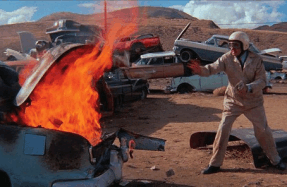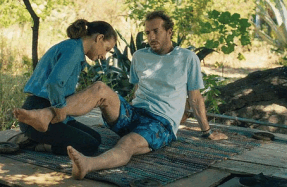The Land Demands Your Effort

Set in the Shiotani Basin, a short train ride from Kyoto, the long-awaited return of C.W. Winter and Anders Edström, a decade following The Anchorage, patiently accompanies Shiojiri Tayoko over five seasons in her small village of 47 predominantly elderly people (most of whom, like Tayoko, play themselves). Though it’s equally concerned with observations of nature and the simple way that life itself is lived, partway through the film a narrative gradually asserts itself, in the worsening sickness of Tayoko’s husband, Junji—though the presence of death is never far from the surface, whether seen through periodic visits to gravesites, fatal snakebite, the hunting of animals for food, or a fantastical story (told via subtitles) of a soldier’s return home from WWII to commune with the corpse of his recently deceased father. The film also illustrates the death of a place and its way of life, a factor of population displacement, and the environmental destruction that’s irreversibly changing the relationship between the villagers and nature.
Time, indeed, is of the essence: at 480 minutes, five chapters, three parts, and two intermissions, The Works and Days clocks in as the seventh-longest feature film ever made—or the third-longest, if one doesn’t count Lav Diaz. But, besides its length, it has little in common with other “long films” or “slow cinema,” mainly due to Winter’s extremely precise editing. The immersive approach and attention to detail and the constant attention to commonplace beauty (and, very often, mystery) make the experience of viewing it far from a chore, unless one considers watching work (and non-work) to be a chore (I prefer to use the term “idyll”).
Given the real-life basis of much of what we see—further compounded by an accompanying 677-page monograph comprised of 23 years’ worth of photographs taken of the village, its surroundings, and Tayoko and her family by Edström (who is her son-in-law)—one might be excused for regarding The Works and Days as a documentary, if, like The Anchorage before it, it did not obliterate the boundaries between fiction and documentary. Winter and Edström do not concern themselves with such conventional cinematic designations, nor, in fact, with “cinema” as such. Even if one can glean the influences of such filmmakers as James Benning and Pedro Costa, the film predominantly draws upon a litany of artistic forebears and thinkers mainly from outside the cinema (a fair number of whom are touched upon in the detailed interview that follows).
Though the process of watching the onset of life’s end yields gut-wrenching moments, some recorded, some reconstructed, it makes little sense to extract one scene from the whole picture, as the film’s ultimate strength lies in its refusal to privilege, well, anything: an image of a tree means as much as a visit to an onsen, three people walking in the dark, a farmer hoeing her land, or a black screen with no image at all, only an intricately composed soundscape (as the quote introducing the film reads, “Until the moment you are dead you can still hear”). Make no mistake: though mortality is front and centre, this is a salute to the possibilities provided by cinema, a celebration of life. This brief introduction does no justice to the experience of watching The Works and Days, an utterly confident, magisterial effort that will stand the test of time.
Cinema Scope: How did you and Anders meet and what led you to work together?
C.W. Winter: The story of our meeting is one of preposterous chance but is maybe too much of a tangent. A short version is that we were both in Berlin on jobs and met by happenstance at a bar. A couple weeks later, en route back home to America, I stopped for a few days in London, where Anders then lived with his wife and son. This was before their daughter—one of our actresses, Mai—was born. And we got to talking about ideas. Those few days were the beginning of what has been one rather long conversation about photographs. How we feel they work or don’t. The ever-shifting lines between the commodity image and the non-commodity image. Images as resistance to the dominant economy or to the sellable choice. Disinterest to allure and to creativity. A preference for plainness. For recursive decisions over taste-based decisions. The sometimes-virtues of failure. The welcoming of underestimation, etc.
Anders’ photography practice began in 1986, and so he was well down that road by the time we met. As an undergrad, I had been aware of and had admired his work. I would frequent a newsstand in Los Angeles run by a Frenchman. He and I would talk about photography and, knowing that I couldn’t afford to be buying loads of magazines, he was nice enough to let me pull up a stool and look through all of their small-press journals as long as I’d buy the occasional one. A number of those publications were coming out of Paris where Anders was living and working at the time. And his work was frequently published in them. I was struck by his sensibility. I found it singularly dissensual—“bad photography” it might have been called at the time—in a way that seemed like some
You’re reading a preview, subscribe to read more.
Start your free 30 days





